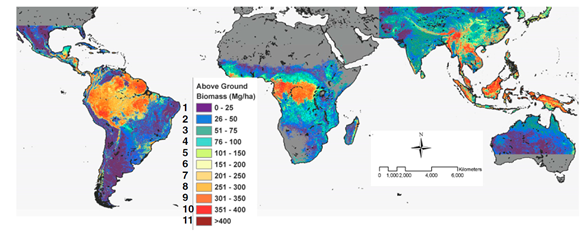It has been far too long since my last full post! I can only
apologise and offer meager excuses of tackling difficult data coursework and
busy times at work! Should be seeing some more regular posts so please check
back soon =) But let us not digress any further!
SO with a rainy Saturday ahead, let's look at how we can
tackle the whole 'how can countries increase their agricultural land without
dramatically reducing carbon storage?' Obviously an ideal situation would be to stop agricultural expansion, however,
this is unfeasible when intensification methods can only take us so far (and also impact upon our environment - to be explored in later posts!) and there is a demand for food and income. With environmental problems
everywhere we turn; we have to find a solution that works in order to avoid land
clearances like those happening in Indonesia.
This is where modelling can help us! One example that I
wanted to share was the work done by
Chaplin-Kramer et al., (2015): these guys modelled the impact on carbon storage of different
agricultural expansion scenarios:
1. Edge: expansion
from forest edge towards the core
2. Core: expansion from the center of forest patches
out towards the edges
3. Fragmentation: expansion
converts the forest pixel furthest from the forest edge in each time step
4. Current cropland: agriculture expands outwards into
whatever is surrounding it.
As we can see the scenarios are quite simplistic; in reality
cropland expansion is not clearly subdivided into these categories and the
authors make clear that their fragmentation scenario is extreme (fragmentation
usually follows road expansion). But, as with all things you have to start
somewhere, so with modelling we have to simplify the scenarios to a certain
extent in order to quantify their individual impact. The scenarios the authors
have chosen allow them to test the
sensitivity
to different
spatial methods of
expansion
of a theoretical
homogeneous, continuous patch of forest to see how their model is working and then assess
the scenarios on study forests in
Mato Grosso and
Mato Grosso do Sul.
What did they deduce?
If you have a single patch of continuous forest and we
convert 30% of it, we can see that carbon stocks are highest for edge expansion, then core expansion, then dramatically lower for fragmentation; from these
findings we can see that carbon stocks are more sensitive to fragmentation.
Now let’s see what happens to carbon stocks of Mato Grosso
and Mato Grosso do Sul when these scenarios are modelled.....
For Mato Grosso interestingly we can see that fragmentation
and core expansion are pretty similar, though edge expansion is still better.
BUT even better than that is expansion out from regions that are already used
for agriculture into surrounding land:
For Mato Grosso do Sul expansion from current cropland is again the better method, and intriguingly core expansions appears to be slightly
worse than the fragmentation scenario:
Hmmmm intriguing results… the reason why we might be seeing
core expansion having a greater impact than fragmentation in Mato Grosso do Sul,
as well as core and fragmentation being almost the same for Mato Grosso is
due to the already fragmented nature of the forests. This is corroborated by looking at the
results when applied to the ‘continuous forest’: the fragmentation scenario has
the greatest impact
initially before
levelling off. So the already fragmented nature of the forests perhaps negates
the effect of the fragmentation simulation....
Even with these limitations considered, what I think we can draw from
this study is that by gradually spreading outwards from existing agricultural
lands and minimizing the number of edges we create we can reduce carbon losses. Yes the more we expand the more carbon we
lose, but if we combine gradual expansion outward from existing agricultural
land combined with sensible agricultural intensification methods then we could
protect our forests of carbon.
But the next hurdle - though we can identify the best
expansion methods, how do we actually put this into practice and persuade
farmers to follow certain expansion policies?
More on this in the next post!





























